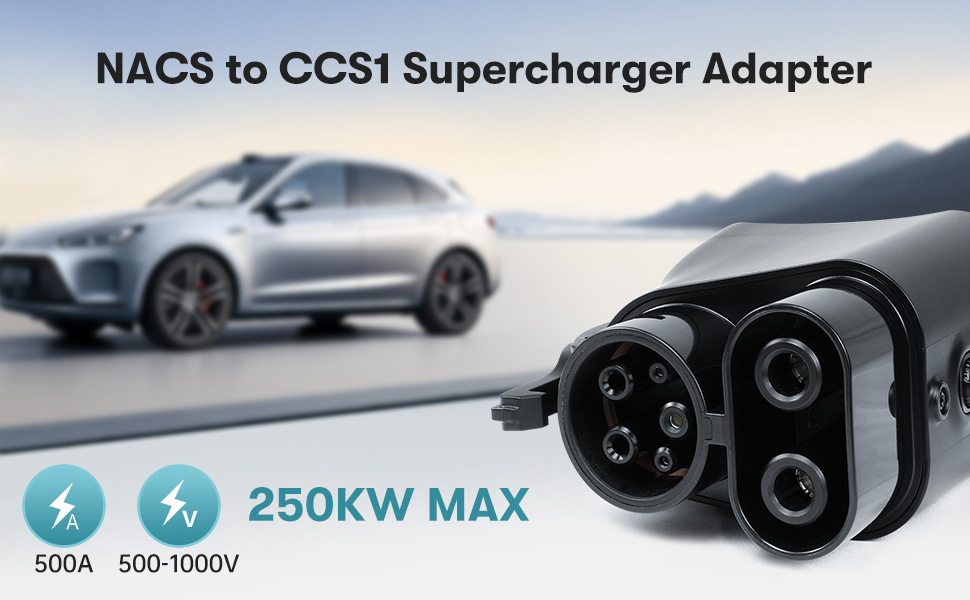
If you’re an EV owner, you’ve likely heard of the NACS to CCS adapter (also referred to as Tesla to CCS1 adapter, Tesla CCS adapter, NACS DC adapter, etc.). Similarly, you may have come across the term CCS1 to NACS adapter (also known as CCS to Tesla adapter, CCS Tesla adapter). These names are so similar that they can easily cause confusion.
Simply put, these adapters exist to bridge the gap between different charging standards.
- If you own a Tesla, you need a CCS to NACS adapter to use CCS1 charging stations.
- If you own a non-Tesla EV, you need a NACS to CCS1 adapter to charge at Tesla Superchargers.
What is a NACS to CCS1 Adapter?
Currently, two major charging standards coexist in North America: NACS (North American Charging Standard) and CCS1 (Combined Charging System 1).
- NACS: developed by Tesla, is used in all Tesla vehicles and has built a vast Supercharger network.
- CCS1: developed by SAE, is adopted by Ford, GM, Rivian, Mercedes-Benz, and other manufacturers, with companies like EVgo and Electrify America deploying CCS1 charging stations.
Unfortunately, these two connector types are not directly compatible. That means:
- Tesla vehicles need an adapter to charge at CCS1 stations.
- Non-Tesla EVs, such as Ford models, require an adapter to charge at Tesla Superchargers.
This is where the NACS to CCS1 adapter comes in, allowing compatible non-Tesla EVs to charge on Tesla’s Supercharger network.
Can I Use a NACS to CCS1 Adapter to Charge My EV?
While the NACS to CCS1 adapter enables non-Tesla EVs to charge at Tesla Superchargers, it does not work for all manufacturers and models. Below is a list of brands and models that currently support charging at Tesla Superchargers using an adapter:
Brands and Models Currently Compatible:
| Brand | Model | |
|---|---|---|
| Ford | Mustang Mach-E | |
| F150-Lighting | ||
| E-Transit | ||
| Escape Plug-In Hybrid | ||
| Rivian | R1S | |
| R1T | ||
| GM | Chevrolet | Bolt EV |
| Bolt EUV | ||
| Blazer EV | ||
| Equinox EV | ||
| Silverado EV | ||
| GMC | Hummer EV Pickup | |
| Hummer EV SUV | ||
| SIERRA EV DENALI | ||
| Cadillac | Lyriq | |
| Celestiq | ||
| Escalade IQ | ||
| Vistiq | ||
| Optiq | ||
| Volvo | C40 | |
| EX30 | ||
| EX40 | ||
| EX90 | ||
| S60 PHEV | ||
| S90 PHEV | ||
| XC60 PHEV | ||
| XC90 PHEV | ||
| Polestar | Polestar | |
| Polestar 2 | ||
| Polestar 3 | ||
| Nissan | Ariya | |
| Lucid | Lucid Air | |
| Lucid Gravity | ||
| Mercedes-Benz | EQB | |
| EQE | ||
| EQS | ||
Brands Expected to Gain Tesla Supercharger Access in 2025:
- BMW
- Genesis
- Hyundai
- JLR
- Kia
What If My Car Isn’t Compatible Yet?
If your EV cannot currently charge at Tesla Superchargers with an adapter, you may still be able to charge at Tesla stations equipped with Magic Dock. This built-in adapter allows CCS1-compatible vehicles to charge directly without needing an external adapter.
How to Find and Use a Magic Dock Supercharger?
Refer to Can a VW ID.4 Use Tesla Superchargers? for step-by-step instructions.
How to Use a NACS DC Adapter?
Using a NACS to CCS1 adapter is very simple. You just need to attach the adapter to the Tesla charger before plugging it into your car. The basic steps are:
Step-by-Step Guide
- Download the Tesla App and create an account.
- Select “Charge Your EV” and locate a Supercharger station.
- Enter your vehicle details and personal detail.
- Add a payment method and follow the on-screen prompts to start charging.
How to Attach the Adapter to the Charging Cable?
4. Important Safety Considerations
Use Only Certified Adapters
Tesla and vehicle manufacturers emphasize using official adapters. Third-party adapters come with a disclaimer, as their safety and reliability may not always be guaranteed.
Why Is Safety Important?
DC fast charging involves high current, which increases electrical and thermal risks. When purchasing a third-party adapter, always ensure that it:
- Has been tested and certified for safety.
- Undergoes rigorous quality checks to prevent overheating or malfunction.
How to Maintain Your Adapter?
- Store it properly and avoid exposure to water.
- Do not modify or tamper with the adapter.
- Check for visible damage before each use.
By following these guidelines, you can safely and effectively charge your non-Tesla EV at Tesla Superchargers using a NACS to CCS1 adapter.
